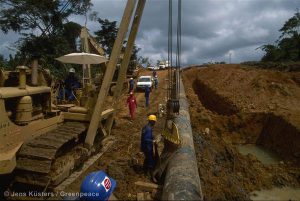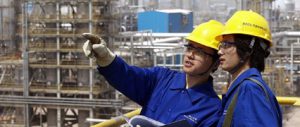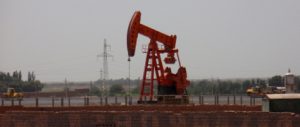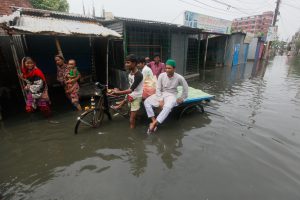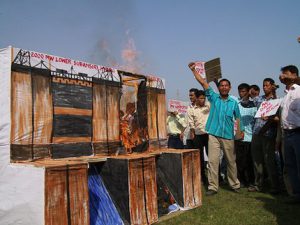Two of China’s biggest oil companies have been hit by unprecedented restrictions in response to their alleged environmental misconduct. China National Petroleum Corp (CNPC) and Sinopec have been banned from building new refineries or expanding current ones for failing to meet emissions targets.
This is the first time the Ministry of Environmental Protection (MEP) has used these restrictions against the two oil giants. Chai Fahe, deputy director of the Chinese Research Academy of Environmental Sciences (CRAES), said that “this moratorium will really shake them up.”
The two companies reacted swiftly. Sinopec announced a three year, 28 billion yuan (US $163 million) “Blue Water, Blue Skies” program, the most intensive and wide-ranging one-off environmental clean-up by any Chinese company thus far.
CNPC offered over seven billion yuan (US $40 million) for improvements, with one MEP official saying “they rushed over to ask us what equipment they needed to meet our requirements.”
According to the MEP, the two companies lack essential equipment: “CNPC has 115 coal-fired furnaces, one third of which have no desulphurisation equipment. None have nitrous oxides (NOx) removal equipment. Of Sinopec’s 174 furnaces, 40% have no sulphur scrubbers, and only 4 have NOx removal equipment.”
Ma Jun, director of the Institute for Public and Environmental Affairs (IPE), was flabbergasted: “Sulphur and nitrous oxide removal are the most basic requirements, even small companies have to do it. It’s unimaginable these companies aren’t doing this, even after repeated checks.”
A lack of oversight
In hindsight, this makes the two companies’ environmental record extremely questionable. Both issued corporate social responsibility reports about six years ago – and were among the first state-owned firms to do so. The environmental sections were substantial and mainly focused on ensuring environmental safety and meeting emissions targets – there was little suggestion of any problems.
Even in 2011 and 2012 – the years in which the MEP says the two firms failed to meet standards – CNPC’s report showed significant drops in four major pollutants. The only discordant note was Sinopec’s admission that in 2012 NOx emissions had increased.
There are also discrepancies between the emissions figures reported by the companies and the data obtained by the MEP. In 2012 the MEP found that chemical oxygen demand emitted by CNPC had dropped by 0.08%, while CNPC’s own report claimed a drop of 1.2% – a fifteen-fold difference.
The figures for the last three years show that in the vast majority of cases the company figures are more favourable than those of the MEP – often by a factor of ten or more.
One MEP official said that in the past the two oil giants were able to do what they wanted on emissions: “But when we increased the number of central state-owned firms under closer monitoring these two were included. The problems came out during rigorous emissions audits.”
Some have argued that increased scrutiny of China’s oil giants is long overdue, citing the issue of fuel standards (which has major implications for air pollution) as representative of general industry obstructiveness. According to Chai Fahe China’s fuel standards have been lagging for years. “The new diesel standards have had to be pushed back twice, and they’re a big reason why.”
Yue Xin, head of the Vehicle Fuel Emissions Laboratory at CRAES said that the two oil giants are hugely influential in setting fuel quality policy. For example, a fuel standard cannot be set without asking the two companies if they can provide that standard of fuel. “Often they just say they can’t, and the draft standard gets scrapped.” The companies also complain of the huge costs involved in meeting higher standards.
Some go so far as to argue that the companies have been in control of the whole process of environmental oversight. “It’s a closed shop, from setting standards, to environmental assessments, to planning and construction, to production,” says Xiang Chun, who works at the Chongqing Liangjiang Voluntary Service Centre, an NGO which has been focusing on EIAs. He reported fraud in seven Environmental Impact Assessments (EIA) submitted by CNPC’s Xinjiang subsidiary to the MEP.
Xiang uses CNPC’s Anning project in Yunnan as an example – the company employed to carry out the EIA was a CNPC subsidiary from Shandong. “The government hasn’t banned them from doing their own EIAs.”
An MEP official admitted that under the planned economy, central state-owned firms became too powerful in certain areas. “They set standards, approve projects, accept the project on completion, then supervise themselves.”
Li Bo, formerly secretary-general of Friends of Nature, contrasted this with the position of many environmental NGOs. “We have no way to influence policy, it’s hard to even find an authoritative expert.” He spoke to over ten specialists trying to find someone to confirm problems with the EIA for a refinery project in Yunnan – but most of them were industry insiders.
A state-owned disease?
Yet CNPC and Sinopec are not without their defenders. “If you want to say they aren’t doing enough on social responsibility, by comparison with who? They’re big and influential, so a small problem can attract a lot of attention,” said Guo Chen, head of the oil, light industry and textiles office at the China International Engineering Consulting Corp.
One official with the China Petrochemical and Chemical Industry Association also thinks the firms are getting a raw deal: “CNPC and Sinopec are Fortune 500 companies with strong technological skills, spending a huge amount – hundreds of millions of yuan, up to a billion a year – on environmental protection technology.”
In terms of internal governance and standards, the two companies have arguably done a lot in recent years. After the 2005 pollution of the Songhua river, CNPC established environmental committees and environmental management departments throughout its operations, with detailed instructions on the rank, human resources and equipment and training necessary. CNPC adopted an industry-recognised health, safety and environmental management system as far back as 1996.
One reason why these companies’ conduct often falls short of these standards is their reliance on subcontractors; accountability suffers as a result. The bulk of the blame for the explosion in Dalian in 2010 was placed on subcontractors.
Though it’s unclear how long the restrictions on Sinopec and CNPC will be in place, the MEPs action may represent a welcome shift towards greater environmental accountability of China’s state-owned energy giants. NGOs trying to change the behaviour of state-owned firms have previously been accused of damaging the national interest. According to Li Bo, it’s common for these companies to “start off taking the moral high ground and just refuse to talk.”
This article was originally published in Southern Weekend on September 12.

